Content Advisory
The Rakshasa section contains depictions of humanoid figures with uncovered upper bodies, including female-presenting characters.
This content is presented in an artistic, non-exploitative context that explores themes of bodily autonomy and cultural relativism. Visitors should be 18+ to view this page.
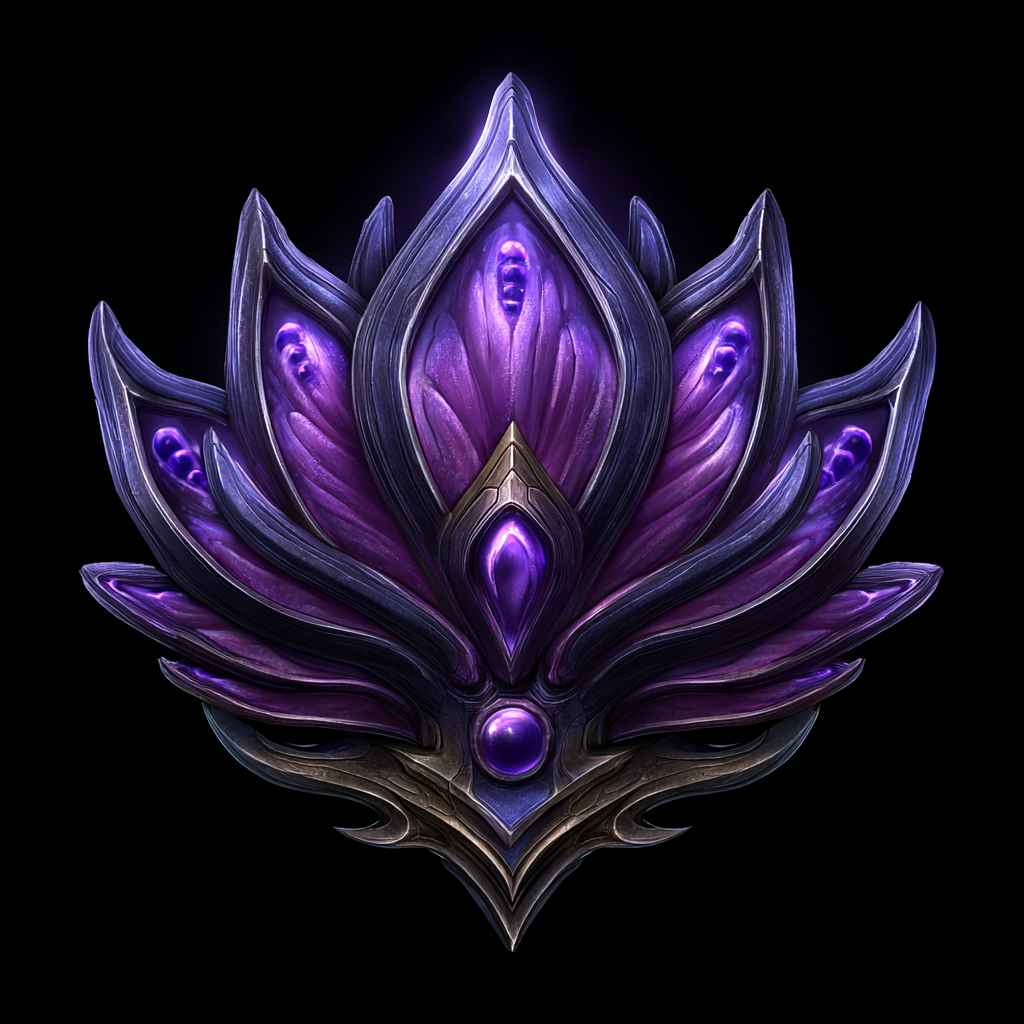
Rakshasa Horde
Commanded by Primarch Moro, the Rakshasa Horde is a formidable force in the Proxima Centauri system, distinct for its integration of psionic Radi-Mons and the SūkṛṃmUc transformation she taught to the first refugees who found sanctuary at her roots. Born from fifty-five surviving vessels of the original 108 ships that fled the Imperium of Dragons’ oppression, the Horde’s population descends primarily from Earth’s Indo-Pacific regions—Indian, Japanese, and Taiwanese cultures forming its ethnic core.
Its Radi-Mons embody the terrifying potential of Eclipse and Mirage spell schools, while the Sūkṛmucs (Worm Witches) serve as both commanders and spiritual anchors, spreading Moro’s philosophy across the system. As of 2295, the Rakshasa maintains cooperative relationships with most Proximan human communities, united by Moro’s central teaching: that embracing desire and primal nature leads to genuine fulfillment and strength.
This philosophical foundation makes the Rakshasa Horde unpredictable and multifaceted in warfare. Yet Moro’s inherited mercy, born from her regard for the ancient Buddha, tempers the Horde’s aggression. They rarely seek total annihilation of enemies, preferring to offer paths to symbiosis. This restraint has made Proxima Centauri a realm of dangerous freedom: low governance, high risk, and unbridled opportunity for those willing to embrace Moro’s way.

Jalrak
जलरक्ष
Created from the Siamese Crocodiles found in Vietnam, the basic and foundational Jalrak thrives across diverse battlegrounds. Its gills and lungs are engineered for dual respiration, enabling unimpeded transitions from deep water to dry land, ensuring operational continuity in amphibious assaults. In vast numbers, Jalraks are deployed to swarm enemy positions, leveraging their numerical superiority and robust physicality. They are the relentless tide of the Rakshasa Horde, capable of wearing down opponents through sheer force and indomitable will.
The Jalrak, an emblem of the Rakshasa Horde’s immense legions, stands as a testament to the brute simplicity of evolution perfected for war. These units, stripped of complex abilities and honed for efficiency, form the core of Rakshasa’s assault strategy on land and sea.
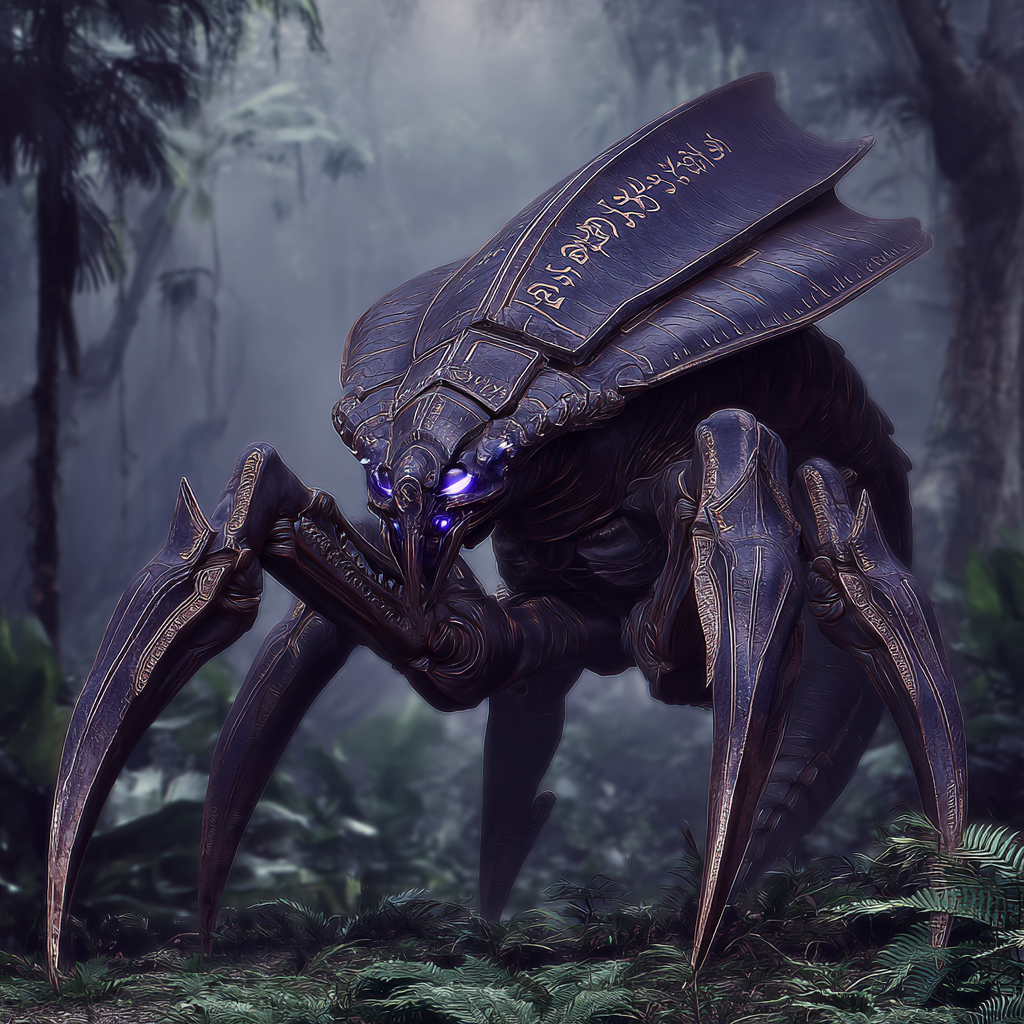
Trishul
त्रिशूल
Bearing some small semblance to ancient Thailand’s Jewel Beetle that served as its genetic template, the Trishul is known for its ranged attack: a penetrating spike launched from its maw. These spikes can pierce through most armors, causing severe damage to its targets. In melee combat, the Trishul is equally fearsome, utilizing its mantis-like arms to tear apart enemies with ease. Its agility and intelligence make it a cunning adversary, capable of quick maneuvers and evasive actions, though its chest area remains a vulnerable target.
Interestingly, the Trishul has a preference for hunting, killing, and consuming male humans. Unless provoked, it never targets female humans. Xenologists in Chiang Mai VII (a highland city on Proxima’s largest moon) speculate that this behavior may be linked to the Trishul’s symbiotic relationship with Worm Witches, who operate in a tentatively matriarchal societal structure.


Padma Lancer (Lotus Lancer)
पद्म भाला (Padma Bhālā)
The Padma Lancers serve as the Rakshasa Horde’s swift-footed guardians and far-ranging scouts, blending ancient warrior traditions with modern firepower. Named for the lotus that blooms in Moro’s waters—beautiful yet resilient—these soldiers embody mobility and adaptability. Clad in flowing purple and black robes that enable silent movement, they patrol Proxima Centauri’s settlements and venture into hostile territory alongside Radi-Mon packs, their distinctive conical hats marking them as Moro’s chosen wardens.
Each Padma Lancer wears a sugegasa woven from Devithar bamboo, harvested from the innermost planet’s nearside forests where the trees endure Proxima Centauri’s relentless stellar radiation. This bamboo possesses extraordinary properties—lightweight enough for marathon treks yet dense enough to deflect kinetic rounds and absorb energy weapon blasts. In close quarters, some Lancers unhook their hats and wield them as improvised shields, the wide brim catching blades and deflecting strikes. Veterans bear hats scarred from countless battles, each crack and scorch mark worn as a badge of survival.
Armed with mag-accelerator rifles compatible with Alliance and Imperium ammunition standards—salvaged, traded, or stolen—Padma Lancers favor hit-and-run tactics over sustained firefights. They excel at reconnaissance, using their mobility to map enemy positions before fading into terrain. In urban defense, they hold chokepoints with disciplined volleys, their hats providing cover while Radi-Mons flank from unexpected angles. Their combat doctrine mirrors the lotus: roots firm in defense, petals open in fluid offense.
Recruitment draws from Proximans who wish to serve the Horde. Some lack psionic potential; others prefer steel and powder to symbiotic flesh. All undergo grueling endurance training across Devithar’s scorched plains and Shashan’s low-gravity craters, learning to operate for days without resupply. Those who complete training receive their sugegasa in a simple ceremony at Moro’s roots, where they swear an oath not to the tree-goddess directly, but to the community she shelters.
Padma Lancers maintain a pragmatic relationship with their Radi-Mon allies, though they rarely meet Moro herself. They lack the pheromone command that Worm Witches have but coordinate through hand signals and psionic relay beacons carried by Weavers accompanying them. In return for their vigilance, Lancers receive priority access to food harvests.
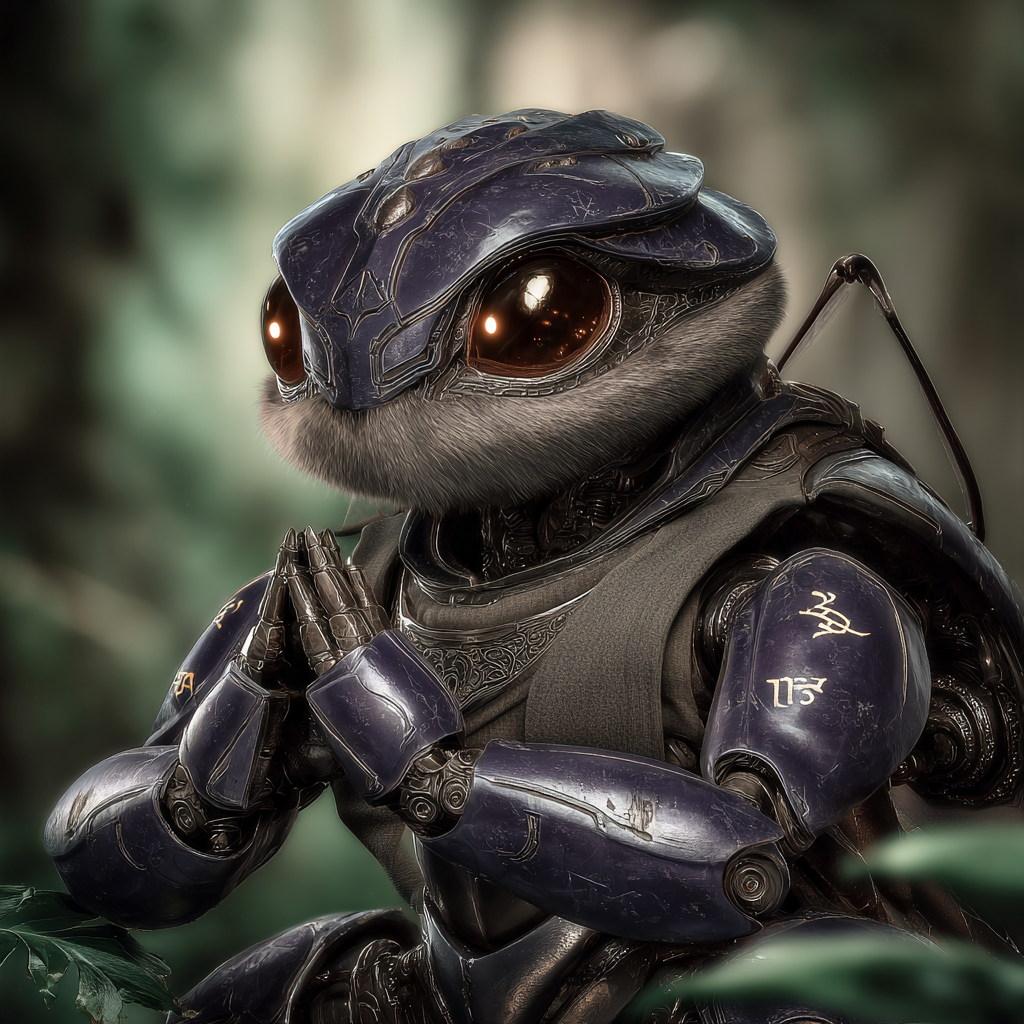
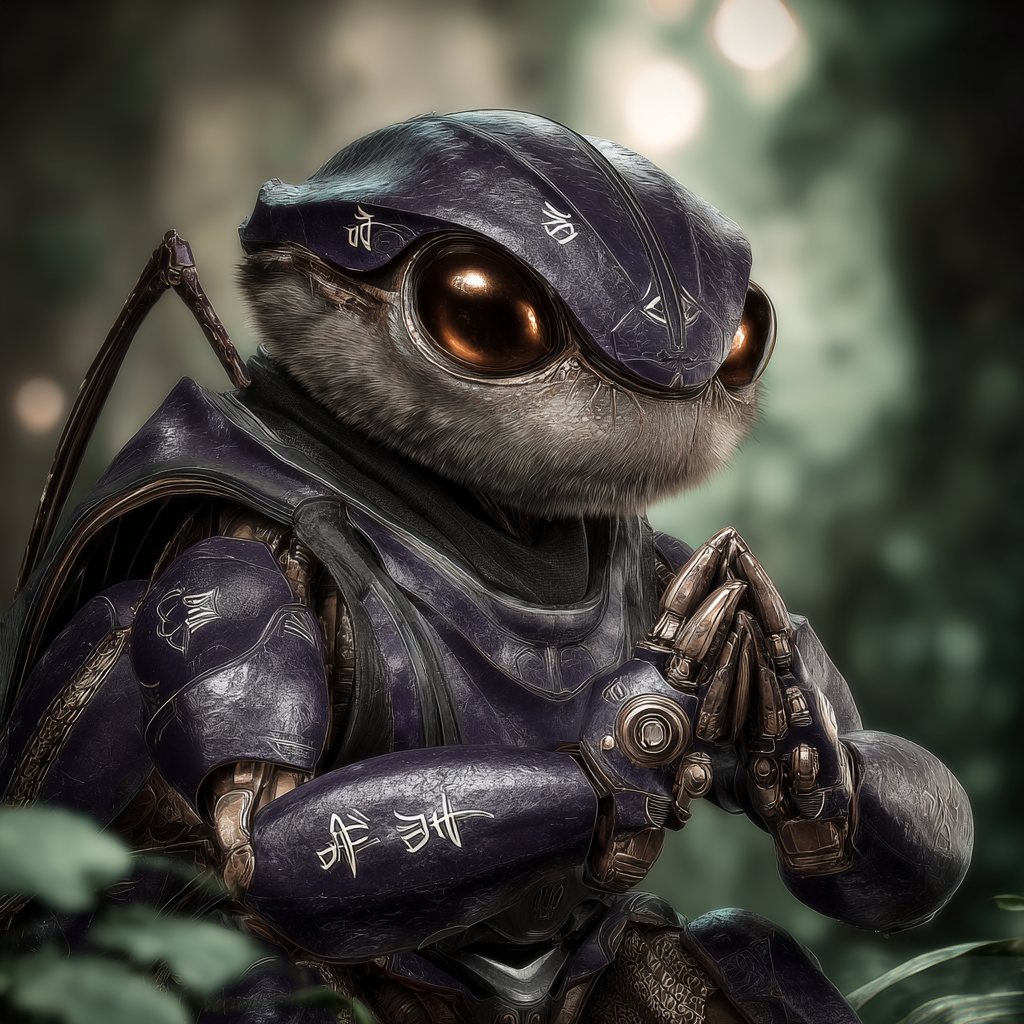
Weaver
मधुकरी (Madhukari)
Resembling giant bees, Weavers are worker units within the Rakshasa Horde. They are responsible for gathering essential resources like Zephyrium and Helionite, as well as constructing and maintaining the horde’s structures. Originally mutated from the Japanese Giant Honey Bee (Apis Lithohermaea), exhibit a diligent and cooperative nature. They are inherently pacifist, focusing solely on their tasks unless provoked. They can quickly erect various structures necessary for the Horde’s operations, such as Hatching Chamber and Chitrapat. Their pheromone communication system enables them to efficiently coordinate large-scale construction and resource gathering without direct oversight.
To protect themselves and their resources, Weavers can burrow underground, creating hidden storage sites and tunnels that facilitate safe transport and concealment from enemies.
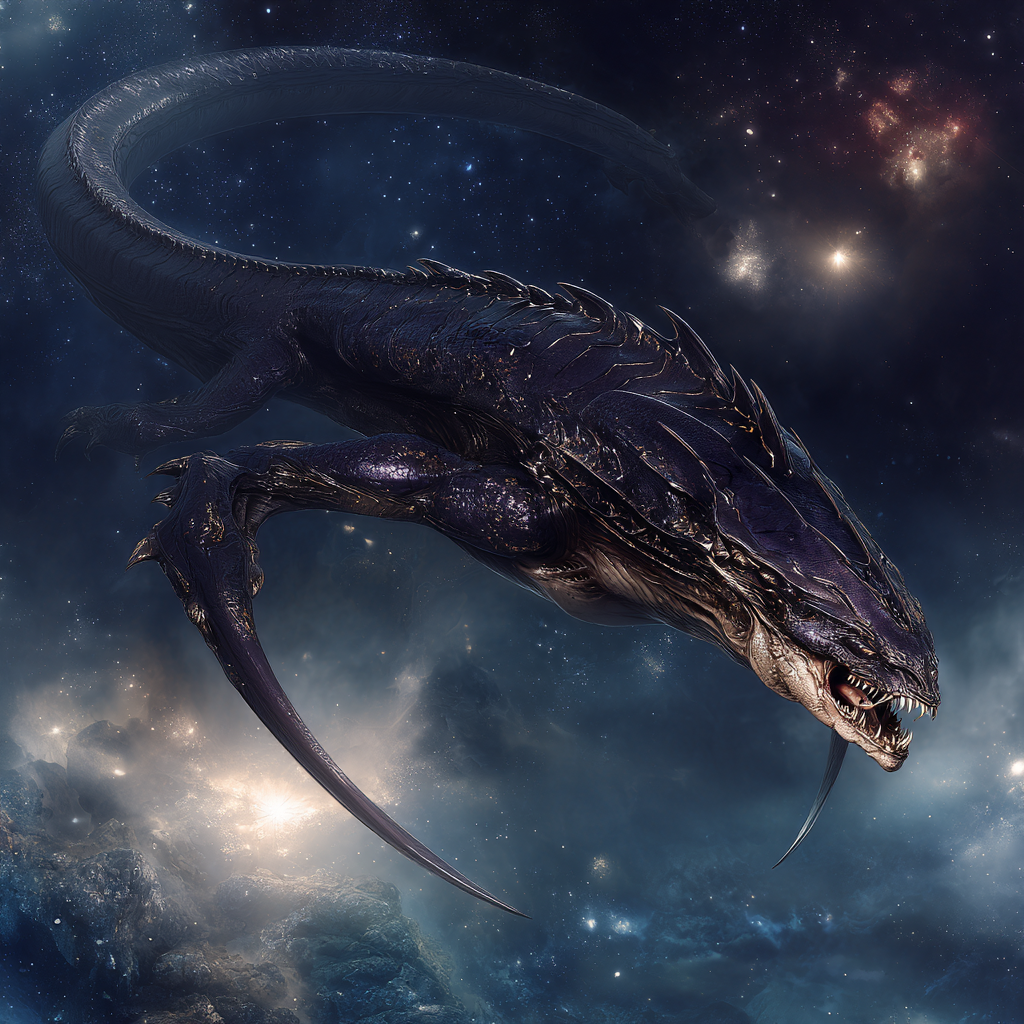
Nāga
नाग
The Nāga, originally mutated from the Indian Mottled Eel, is a flying unit known for its agility and quickness in air-to-air combat. These Radi-Mons are revered for their grace and ferocity in the skies, embodying the essence of swift and deadly aerial warfare.
Nāga are incredibly agile and can maneuver swiftly in the air, making them excellent at dodging attacks and engaging in quick, precise strikes. Equipped with sharp claws and powerful jaws, they excel in air-to-air combat, capable of taking down enemy aerial units with ease. They can also emit a powerful sonic screech that disorients and stuns enemy units, providing a tactical advantage in combat. Their keen senses and echolocation abilities make them excellent scouts, capable of gathering intelligence and detecting enemy movements from above.

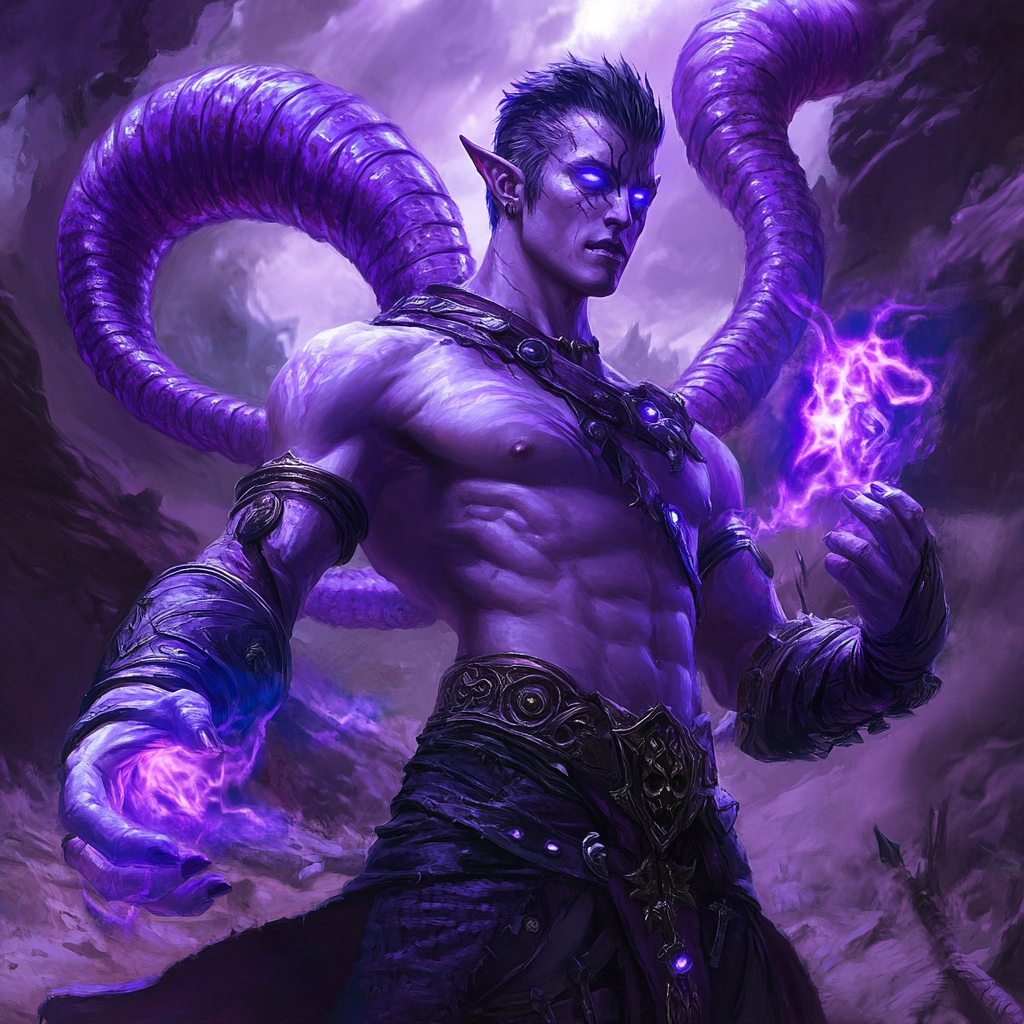


Sūkṛmuc (Worm Witch)
सुक्र्मुच् (Soo-kr-mooch)
The Sūkṛmucs are humans who willingly contract the Rakshasa variant of the Nucleus Virus, becoming transformed into powerful, shape-shifting entities. Unlike other Radi-Mon variants created through forced conversion, Sūkṛmucs must choose their transformation, accepting the virus through consensual intimate contact with an existing Sūkṛmuc.
All Sūkṛmucs possess the ability to shapeshift between their human form, a serpentine worm form, and a metamorphosis form, granting them versatility in both combat and traversal. Male and female Sūkṛmucs serve complimentary but equally vital roles. Males typically act as pathfinders, scouts, and frontline defenders, venturing into dangerous territories to expand or protect Rakshasa domains. Females often serve as guardians of sacred sites, local hive matrons, and keepers of the Hatching Chambers.
Despite the numerical advantage of males, the Rakshasa society maintains a matriarchal structure, with female Sūkṛmucs holding greater decision-making authority, particularly the eldest among them.
Both genders excel in Mirage spells and can converse fluently in Devavāṇī. They secrete pheromones that compel other Radi-Mons to follow their commands, making them natural leaders within the Horde’s hierarchy and invaluable assets in complex operations.
Both male and female Sūkṛmucs have highly acidic body waste. The digestive systems of Sūkṛmucs have also evolved to process nearly any form of flesh with remarkable efficiency, allowing them to sustain themselves in environments where other beings would starve.
The social structure of Sūkṛmucs follows the sacred principle of “बहुविवाहः” (Bahuvivāhaḥ), a polyandrous mating system where female Sūkṛmucs typically bond with multiple male partners. This practice ensures genetic diversity. Each female Sūkṛmuc is encouraged to maintain relationships with several males throughout her centuries-long lifespan. These bonds form complex familial units where each male contributes unique strengths and knowledge to their collective offspring’s development.
When disputes arise among local Horde leaders, the opinions of female Sūkṛmucs are given particular weight, especially in matters concerning resource allocation, and long-term planning. Their perspective is considered more attuned to the ways of their Proxima Centauri homeland and the will of Primarch Moro.
The Tasting
परीक्षण (Parīkṣaṇa)
The Tasting stands as the Rakshasa Horde’s ultimate trial of desire and discipline, a journey through Primarch Moro’s lower body on Bodhasya Parvatah. Reserved for Proximans aspiring to become Worm Witches or outsiders seeking her rare boons, the ritual demands that participants—known as the Tasted—navigate Moro’s evolved anatomy, remnants of her ancient Nirboh body now woven into living root and chamber. Success requires embracing primal urges without surrender, transforming raw passion into controlled power. Failure means blissful death, the Tasted lost forever in ecstasy’s grip.
The ritual unfolds in phases, each drawing from Moro’s philosophy of fulfilled desire. It begins at the mountain’s base, where the Tasted enters alone.
Moro’s Grove: The first challenge manifests as a tangled thicket of dark purple and black vines rising like a wild barrier. These strands, evolved from Moro’s human pubic hair, release a heavy musky scent—warm and sweaty, stirring deep arousal in those who linger. The air grows thick with temptation, urging the Tasted to sink into endless pleasure and forget their quest entirely. Many perish here, dying content without struggle. Only those who acknowledge their desires yet cling to purpose push through, emerging disciplined but awakened.
The Corona: Beyond the Grove waits a narrow opening slightly shorter than an adult, sealed by a massive leaf that was once Moro’s hymen. Above it dangles a swollen nectar pod—previously her clitoris—glistening with promise. The Tasted must approach and draw from it, sucking and teasing as in an act of cunnilingus. If pleased, Moro releases a sudden squirt of nectar, parting the leaf to allow passage. This marks entry into her depths, though the true test has only begun.
Moro’s Canal: Inside stretches a straight passage born from her vagina and cervix, its pink fleshy walls pulsing with heat and life. The scent intensifies here—hot, inviting, overwhelming—as the walls contract in rhythmic squeezes, massaging and embracing the Tasted with every step. The urge to yield grows unbearable, the flesh threatening to cradle them into eternal rest. Survival demands steady progress, resisting the seductive pull while drawing strength from it.
The Womb Vault: Deeper still lies a spacious chamber evolved from Moro’s uterus, where combat awaits. Packs of Jalrak and Trishul prowl these bioluminescent halls, testing the Tasted’s mettle. Victory demands more than brute force—the slick floors and pulsing walls can serve as advantage or hindrance depending on the Tasted’s adaptability. Weapons, spells, and cunning all have their place, but survival requires reading the chamber’s living rhythm.
The Taster: Those who prevail meet the final arbiter—a Worm Witch in full metamorphosis form, her limbs shifted into writhing tentacles while face, breasts, and torso remain human. She oversees the ultimate rite, binding the Tasted in precise, BDSM-like holds: one tentacle penetrates the anus to extract waste, another stimulates genitals to draw semen or vaginal fluids, all while maintaining arousal without overwhelming. These essences are collected in a botanical bowl at a root’s base, offered for Moro to absorb through her network.
If pleased, Moro grants her gift: initiation as a Worm Witch for Proximans, or a boon of power for outsiders—enhanced psionics, symbiote bonds, or forbidden knowledge. The Tasting embodies the Horde’s core philosophy: desire as forge, intimacy as strength, where the body yields secrets the mind alone cannot grasp. Survivors often weave what they’ve learned into polyandrous bedsport, the ritual’s intensity bonding them to partners in ways conventional intimacy never could.

Breeding Lotus
पद्म कक्ष (Padam Kaksh)(育種蓮)
The Rakshasa transcended crude breeding through philosophy made flesh. Their Breeding Lotus extracts and amplifies the essences released during conscious union, a living architecture responding to genuine connection.
Each Breeding Lotus consists of 108 hexagonal cells arranged in a lotus pattern, constructed by Weavers using Zephyrium-infused organic resin. At the center lies the “Bindu Pool”—a crystalline reservoir containing a specialized enzyme solution that can extract and preserve genetic material at the molecular level.
When a female Sūkṛmuc and her chosen partner(s) engage in ritualistic sex within the Breeding Lotus, their combined sexual fluids—what ancient texts called white and red bodhicitta—are absorbed by the living walls through microscopic extraction channels. The chamber’s bio-architecture responds to heightened psionic states during climax, drawing genetic material. Through controlled quantum cloning, each cell develops into a different Rakshasa form: Jalrak, Trishul, Weavers, fellow humans (rarely) or any creature the Primarch knows of. The process takes 69 days, following lunar cycles that the Rakshasa consider sacred.
Marriage as a concept doesn’t exist in Rakshasa society. Female Sūkṛmuc typically maintain multiple partners throughout their centuries-long lives, each contributing unique genetic traits to the collective offspring. This polyandrous system ensures genetic diversity.
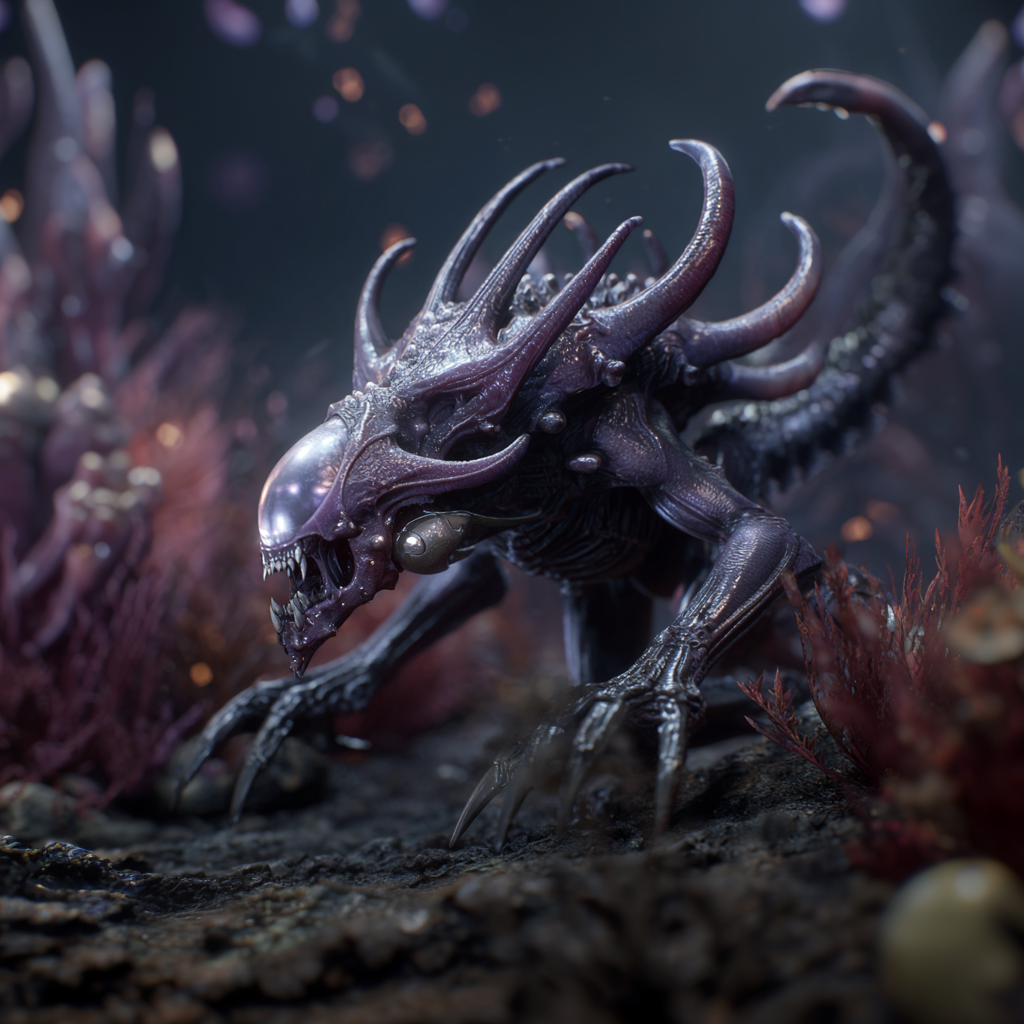
Corpse Gorger
शव ग्रासक
Corpse Gorgers are shambling horrors pulled from the twisted voids of Proxima Centauri, summoned through a Worm Witch’s lantern portal. These beasts look like hunched, four-legged hounds pieced together from rotten bones and purple flesh, with a single glowing eye that stares out from a skull-like head. They move slow but steady, their joints creaking like old doors, always pushing forward no matter the hits they take.
In battle, they’re the Horde’s relentless foot soldiers—tough enough to soak up punishment while closing in for brutal close-up fights. Their jaws snap with moderate force, tearing into enemies without flair, just raw persistence. Worm Witches call them up in packs, up to ten at a time, to overwhelm foes or guard key spots. The creatures feed on fallen bodies, growing stronger mid-fight by gulping down chunks of meat, which helps them last longer in drawn-out scraps.
Tied to the Rakshasa’s cycle of life and decay, Gorgers represent the Horde’s way of turning death into strength. Some Witches bond deeper, letting a Gorger linger after summons to scavenge around camps or even join in darker rituals where the beast’s hunger mirrors the host’s own urges. In quiet moments, a few have been known to use tamed ones for twisted play, the creature’s rough hide adding a thrill to private encounters within the polyandrous bonds.
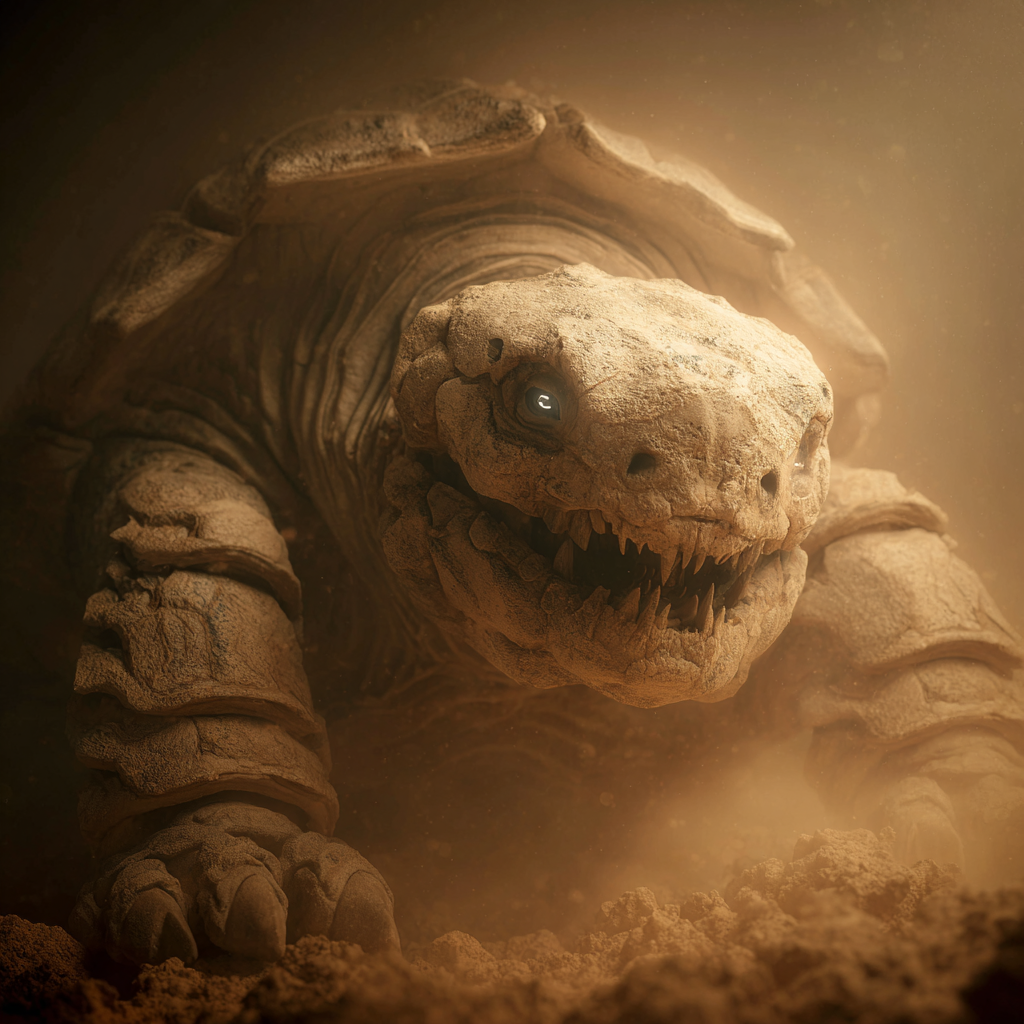



Jinki (神亀)
जिन्कि
Jinkis are towering psionic constructs summoned by Worm Witches, shaped like giant turtles lumbering on powerful hind legs. Standing twice the height of a human, their shells crackle with Mirage energy, broad jaws set in a perpetual grimace, eyes glowing with the material that birthed them. These god-turtles draw from Japanese legends of divine guardians, twisted into Rakshasa weapons that anchor the frontline like unyielding walls.
Witches mold them from raw stuff: plain clay for basic tanks that draw enemy fire with rumbling taunts; fresh blood for drainers that siphon life back to their summoner; bone for psionic bruisers inheriting a loved one’s fight style; even foul feces for rot-spreading horrors that melt foes in miasma. Each type is unique in purpose and flair, but all are ready to serve the Horde. Due to the structural limitation of human brains, a Worm Witch can only summon and control one Jinki at a time.
In combat, Jinkis soak hits that would shatter lesser summons, their slow plod turning into battering rams up close. Packs of lesser minions swarm behind them while the turtle holds the line, its shell shrugging off blasts. Off the field, some Witches keep personal Jinkis as camp sentries or ritual aids, their sturdy forms lending a primal thrill to polyandrous rites—especially when forged from a lover’s bone or seed, binding beast and bed in one.
The diversity mirrors the Horde’s adaptability: a Jinki from battlefield scrap fights dirty and mean, while one from a mate’s essence pulses with shared vigor, turning defense into something fiercely intimate.
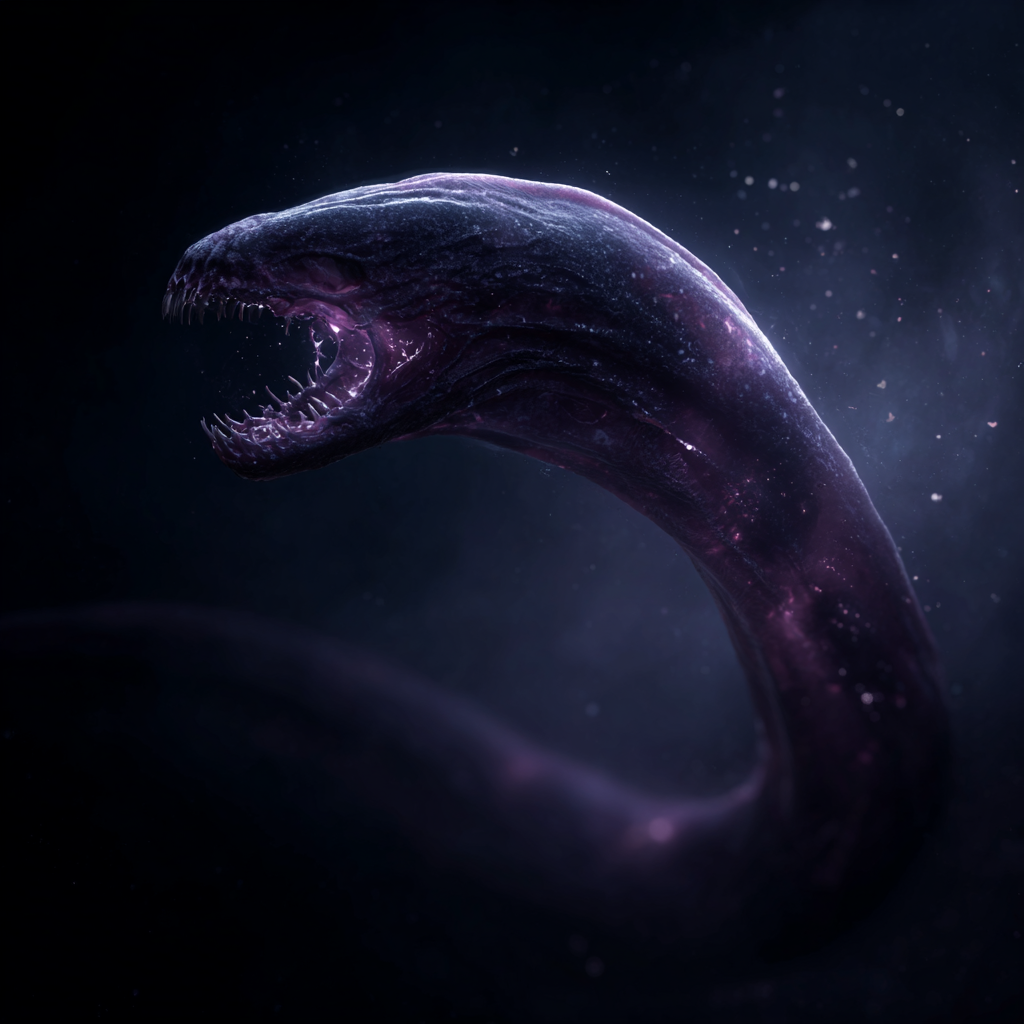
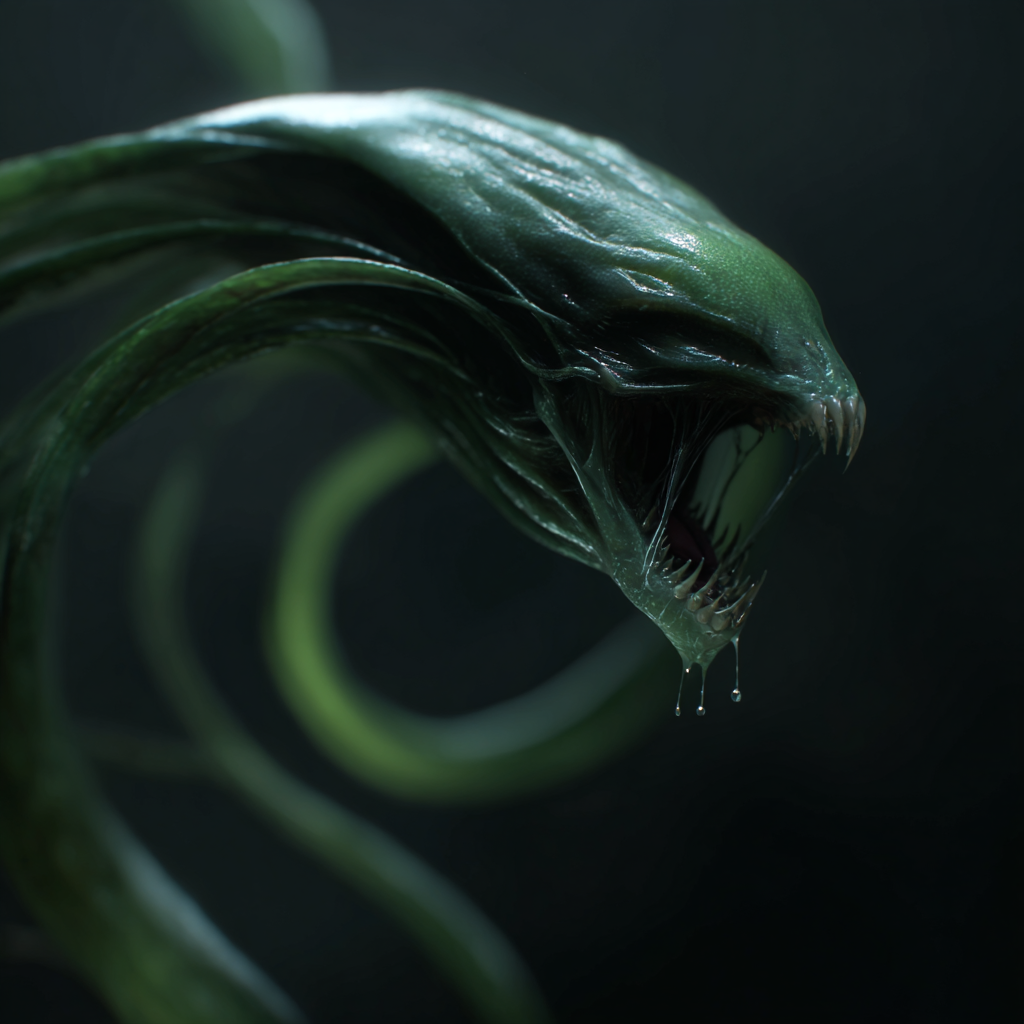
Proxima Creeper
प्रॉक्सिमा वल्ली
Evolved from Taiwanese Earthworms (Metaphire Taiwanensis) consuming Helionite (nuclear fusion waste), Proxima Creepers are the living symbiotes from Proxima Centauri that bond with every Sūkṛmuc. These slender, vine-like organisms nest in the host’s stomach, intestines, and—for females—the womb, ready to emerge through natural orifices as autonomous weapons. When called out, they slither free with a wet, stretching pull, their tendrils glistening under harsh lights, coiling like hungry snakes before striking.
The relationship runs deep and personal. Creepers constantly cleanse their host’s internals, secreting enzymes that break down toxins, wipe out pathogens, and keep everything running smooth. This gives Worm Witches a tough edge against disease, gut troubles, and even radiation burn. Female witches feel their cycles steady out, cramps fading to nothing, which fits right into the Horde’s open breeding ways. Male witches gain a raw boost in endurance and Aether pull, their bodies buzzing with extra life. All Creepers have genders which mirror that of their host’s.
Female witches have three ways to let their Creepers out: mouth, vagina, anus. Males stick to two: mouth and anus, their urethral path literally too small for Creepers to traverse. To balance it, male Creepers grow thicker and stronger—half again as big, packing a heavier punch in fights.
Rituals summon specialized types: Poison Creeper from the anus, Carrion Creeper from the vagina, Semen Creeper from the mouth. They draw strength from things like blood or fresh essence, shifting to handle whatever threat comes. Guided by pheromones, they move in sly packs, biting and wrapping foes, then slipping back inside to rest and feed off scraps.
In private moments, some Sūkṛmucs weave Creepers into their bedsport for thrills—tendrils teasing sensitive spots during coupling, heightening the rush in ways that blur pain and pleasure. It ties into their bold, shared bonds, turning symbiosis into something raw and intimate.





